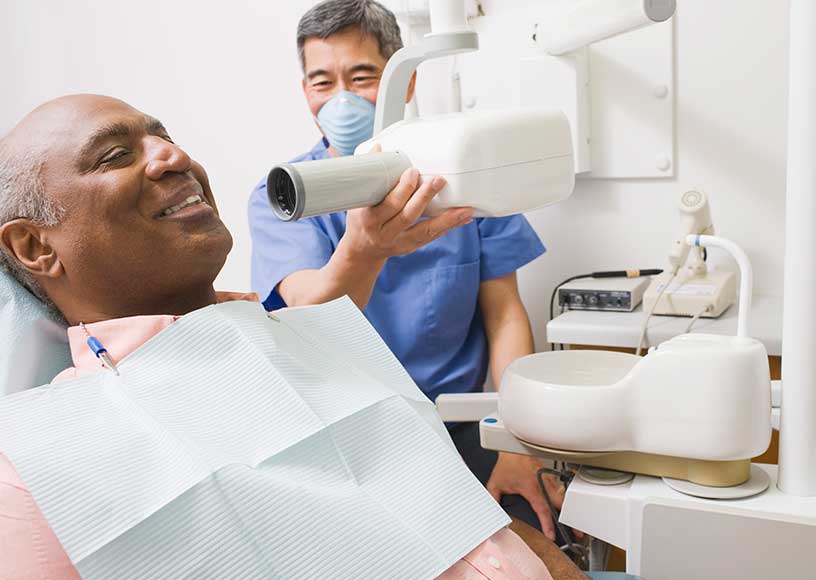5 reasons to see the dentist — even if your teeth are fine

Brushing and flossing twice a day may go a long way toward keeping teeth and gums healthy. But that’s just part of a good oral care routine. It’s important to see a dentist every 6 months for a preventive checkup.1
“Preventive care is essential to maintain a healthier mouth,” says Fatima Khan, D.M.D., a dentist with Altus Dental in Houston. “Seeing a dentist twice a year helps catch and address any dental issues early on.”
You might think you don’t have any dental issues. Especially if your teeth feel and look fine. But skipping a checkup or two could end up causing problems later. And that may be bad for your mouth and your wallet.
Here are 5 good reasons to stick to that 6-month routine, and how it may be good for oral health — and overall health.
1. Get a thorough cleaning
Even a good electric toothbrush isn’t a match for a dentist’s cleaning equipment. That’s why a professional dental cleaning is part of a routine twice-yearly exam. Their metal tools can dig out plaque that a toothbrush or floss can’t reach.
Plaque is the sticky film on your teeth. Everyone has it. It’s a combination of saliva mixed with the bacteria from everything you eat and drink.2 If it’s on there for months (or years) it hardens and becomes tartar.
Tartar is even harder to clean with just a toothbrush. But the real problem is that all that bacteria can lead to cavities and gum disease. Both are bad for your health, including your heart. And they may require pricier and more extensive treatments.2
Cleaning also involves brushing and polishing teeth. And it will probably include a fluoride treatment to prevent cavities. If it looks like you could be doing a better job brushing and flossing at home, the hygienist may give you a tutorial at the end of the cleaning.
2. Checkups can uncover hidden problems
After the cleaning, the dentist will check the way the upper and lower teeth line up together your mouth is closed.3 (Dentists call this the “bite.”) When teeth don’t line up properly, it may cause jaw pain and trouble with breathing, eating and talking. If the teeth have shifted a lot, the risk of gum disease and tooth decay increases too.4
At least once a year, the dentist may take x-rays. They may be the best way to see if anything in your mouth has changed. Dentists use x-rays to spot potential problems that are hidden from view, notes Dr. Khan.
These include cavities between your teeth (yes, that happens) or issues with the bones that surround and support your teeth, explains Dr. Khan. Dental x-rays may also help the dentist find decayed fillings, infections, cysts, abscesses and bone loss.
3. It helps prevent serious issues
Dental problems increase as you age. About two-thirds of people aged 65 and older have gum disease and 1 in 5 have untreated tooth decay.5
There are also other problems that affect the teeth with age. “The quantity and quality of our saliva diminishes, and people suffer from dry mouth,” notes Dr. Khan. The enamel on the teeth gets thinner and gums recede too. Both increase the risk of cavities, she adds.
A dentist may catch these issues if you go in regularly. They fill cavities so they don’t destroy the inside of your tooth. The dentist may also discuss how to treat dry mouth and remove plaque so the bacteria won’t harm the gums.
Otherwise, decay and bacteria cause inflammation. And that can be bad for overall health. Gum disease has been linked to heart disease and diabetes.6
4. A dentist may spot cancer
Dentists are trained to catch cancers that affect your mouth or throat, such as the tonsils. That’s why during the checkup, a dentist will look for lumps. They’ll also feel your jaw and neck for anything unusual.
When people keep up with regular checkups, dentists are often the first ones to notice the signs of oral cancer. And finding one of these cancers early is the key to successfully treating it.7
5. You’ll put dental coverage to good use
Many health care plans include dental coverage with routine dental checkups. Taking advantage of those exams and catching problems early may be far less expensive than what it would cost if serious problems developed. For instance, it may be easier and less expensive to treat a small cavity than to pay for a root canal or replace a missing tooth that had to be pulled.
So take advantage of dental coverage. And schedule those 6-month routine checkups today.
